2.93GHz with DDR2-1067 Performance Comparison
It is clear enough that despite the poorer memory bandwidth, Core 2 Duo is the performance leader by a substantial margin at stock speeds. You have seen that in all of the results posted in this article. This conclusion will not satisfy all our readers, however. Many have theorized every incarnation of performance imaginable with AM2 having higher clock speed, higher bandwidth, or higher speed memory than it currently does.
To best answer these questions we put together the fairest comparison we could think of to directly compare Core 2 Duo and AMD AM2. This consists of running both processors at the exact same speed - 2.93GHz - achieved at the same ratios - 11x266. This involves overclocking the AM2 FX62 to 2.93GHz and raising the "bus" speed to 266. That allows an 11x266 ratio to match Core 2 Duo. The desirable side effect is that while AM2 does not really support DDR2-1067, by setting the memory to DDR2-800 we reach DDR2-1067 speed at the 266 speed setting. While this slightly stacks the deck in AMD's favor, it is as close as it is possible to get at running the two systems at the same speed, same memory timings, same memory voltages, same memory, and same video card. We are comparing two identically configured systems with AM2 powering one system and Core 2 Duo powering the other system.
Results are particularly interesting in that the fastest current AM2 processor, the FX62, is overclocked about 5% in CPU speed and 33% in "bus" speed over a stock AM2 system.
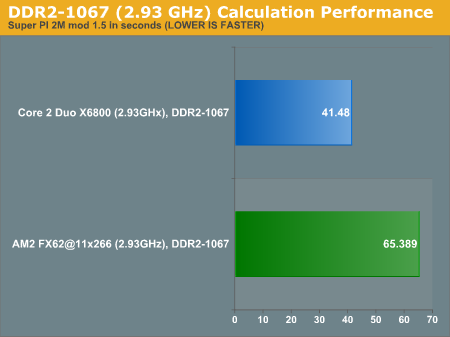
Frankly the gap that remains in Super Pi results when comparing AM2 and Core 2 Duo at the same speed was something of a shock. Clock for clock, with all other variables the same, Core 2 Duo is still almost 60% faster than AM2. There is nothing complex about calculating the value of Pi to 2 million places, but it does show the true power of Conroe in computation-intensive tasks.
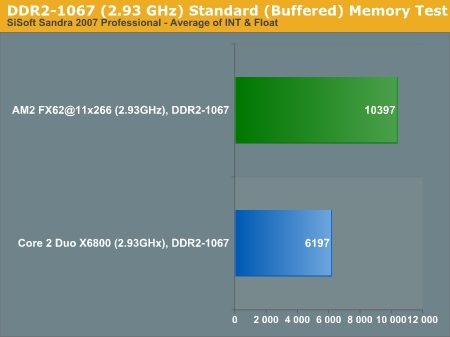
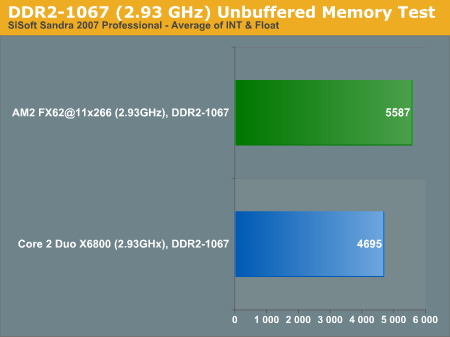
Despite the improvements Intel has made in intelligent read-ahead for memory, AM2 still has a huge lead in buffered memory bandwidth. This is a result of the superior on-processor memory controller used on AM2. The results become much closer in Unbuffered memory results, which is normally more revealing of performance in real-world applications, but AM2 still has a wider memory bandwidth. The unfortunate reality is AM2 is not starved for memory bandwidth and cannot really make effective use of this advantage. AMD clearly knows how to deliver memory bandwidth, so the task now becomes to modify their core logic to make better use of this advantage.
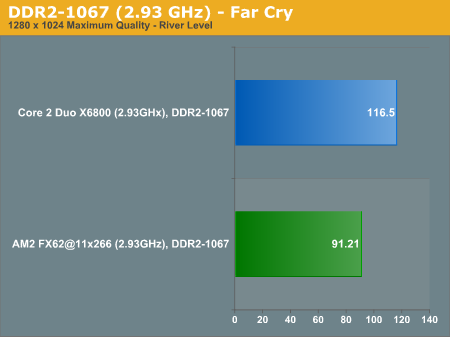
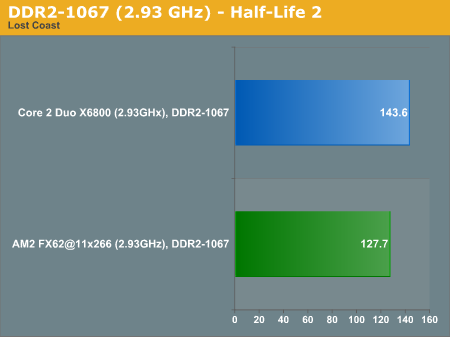
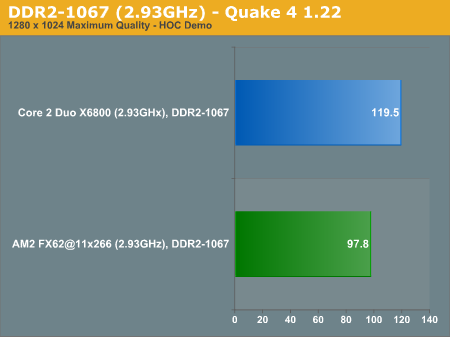
We can now say with authority that Core 2 Duo is the faster performer clock-for-clock across the board. At the same 2.93GHz Far Cry is 27.7% faster, Half-Life 2: Lost Coast is 12.4% faster, and Quake 4 is 22.2% faster on Core 2 Duo. Of course AMD does not currently have a 2.93GHz CPU, so we tested by overclocking FX62. This suggests that FX64, or whatever it will be called, will not help much at 3.0GHz with a 200 clock speed.
It is clear enough that despite the poorer memory bandwidth, Core 2 Duo is the performance leader by a substantial margin at stock speeds. You have seen that in all of the results posted in this article. This conclusion will not satisfy all our readers, however. Many have theorized every incarnation of performance imaginable with AM2 having higher clock speed, higher bandwidth, or higher speed memory than it currently does.
To best answer these questions we put together the fairest comparison we could think of to directly compare Core 2 Duo and AMD AM2. This consists of running both processors at the exact same speed - 2.93GHz - achieved at the same ratios - 11x266. This involves overclocking the AM2 FX62 to 2.93GHz and raising the "bus" speed to 266. That allows an 11x266 ratio to match Core 2 Duo. The desirable side effect is that while AM2 does not really support DDR2-1067, by setting the memory to DDR2-800 we reach DDR2-1067 speed at the 266 speed setting. While this slightly stacks the deck in AMD's favor, it is as close as it is possible to get at running the two systems at the same speed, same memory timings, same memory voltages, same memory, and same video card. We are comparing two identically configured systems with AM2 powering one system and Core 2 Duo powering the other system.
Results are particularly interesting in that the fastest current AM2 processor, the FX62, is overclocked about 5% in CPU speed and 33% in "bus" speed over a stock AM2 system.

Frankly the gap that remains in Super Pi results when comparing AM2 and Core 2 Duo at the same speed was something of a shock. Clock for clock, with all other variables the same, Core 2 Duo is still almost 60% faster than AM2. There is nothing complex about calculating the value of Pi to 2 million places, but it does show the true power of Conroe in computation-intensive tasks.


Despite the improvements Intel has made in intelligent read-ahead for memory, AM2 still has a huge lead in buffered memory bandwidth. This is a result of the superior on-processor memory controller used on AM2. The results become much closer in Unbuffered memory results, which is normally more revealing of performance in real-world applications, but AM2 still has a wider memory bandwidth. The unfortunate reality is AM2 is not starved for memory bandwidth and cannot really make effective use of this advantage. AMD clearly knows how to deliver memory bandwidth, so the task now becomes to modify their core logic to make better use of this advantage.



We can now say with authority that Core 2 Duo is the faster performer clock-for-clock across the board. At the same 2.93GHz Far Cry is 27.7% faster, Half-Life 2: Lost Coast is 12.4% faster, and Quake 4 is 22.2% faster on Core 2 Duo. Of course AMD does not currently have a 2.93GHz CPU, so we tested by overclocking FX62. This suggests that FX64, or whatever it will be called, will not help much at 3.0GHz with a 200 clock speed.










118 Comments
View All Comments
zsdersw - Tuesday, July 25, 2006 - link
I care about people making blatantly false claims.Wesley Fink - Tuesday, July 25, 2006 - link
We used the SAME memory timings on both processors if they were available. For the DDR2-1067 and DDR2-800 they were exactly the same on both processors in all tests, which is why they were used for our 2.93GHz comparison. At DDR2-667 and below, the Core 2 Duo could support timings like 3-2-2, where AM2 only supports 3-3-3. This article was to evaluate memory performance, so we did everything possible to keep all variables the same.Memory timings were DDR2-400 - 3-2-2-5; 533 - 3-2-2-6; 667 - 3-2-3-7; 800 - 3-3-3-9; 1067 - 4-3-4-11; DDR2-1112 - 5-4-5-14.
duploxxx - Wednesday, July 26, 2006 - link
well those cas settings were to be expected when you saw the memory performance chart.you just killed the performance after ddr2 800 cas4 is ok but the minor step you have from ddr 1067 to ddr 1112 and again 1 cas higher is the end of good performance. so the memory of the fx to get to 2.9 was? that explains probably the lower performance vs the linear performance increase in the memory.....
Bingo13 - Wednesday, July 26, 2006 - link
The timings utilized by AnandTech were about the best you will see with current DDR2 memory. They did not kill the performance, the memory capability is what limited the testing. Tell me, where can you buy DDR2 that will do 3-3-3-9 at 1067. This review was more than fair in the settings it utilized for the tests and it took $450 memory to do it.
duploxxx - Thursday, July 27, 2006 - link
yes i know but you don't get my point...we know fx34 will be 3.0 so its stupid to try and get an fx at 2,93.
run an fx at 3.0 (multiplier change) with the nice cas3-3-3 like you did and the performance will be way better. now you killed the performance (speedbump cpu and memory) by dropping the cas to 4
Wesley Fink - Wednesday, July 26, 2006 - link
DDR2-800 was 3-3-3-9 2.2V. The FX at 2.93GHz was running DDR2-1067 at 4-3-4-11 2.2V.Gary Key - Tuesday, July 25, 2006 - link
We had a slight change in pages after the article went live. Page seven now represents stock memory performance on each platform with page eight now showing the overclocked FX62 (11x266, 2.93GHz) compared to the X6800 (11x266, 2.93GHz). A comparison that is quite revealing based upon numerous comments about what the expected results of running a high memory strap and low latency settings on the AM2 platform would even out the performance differences between the two platforms.Wesley Fink - Tuesday, July 25, 2006 - link
We were moving pages around as it posted. The page references should now be correct. The page that AMD fans will likely hate is now page 8.